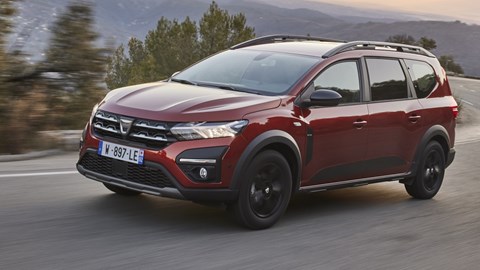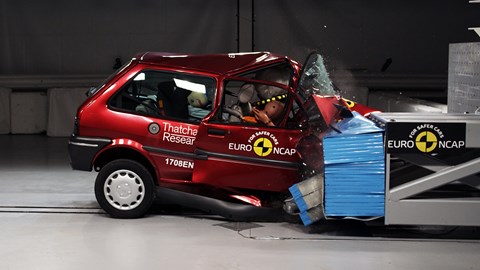► A one-star safety score should be damning…
► … if Euro NCAP had tested the car in question
► Tom Wiltshire casts doubts over crash testing
The latest batch of Euro NCAP (New Car Assessment Program) safety ratings could make for uncomfortable reading for those of us who, just a few weeks ago, championed the Dacia Jogger as the best inexpensive family car since the Citroen Sliced Breadlingo.
In amongst four and five-star ratings for the Honda HR-V and DS 4, Dacia’s new family car was presented with a one-star safety rating.
Safety scores aren’t a typical Dacia strong point, and when we sat in the product presentation being told about the Jogger’s trim levels, I’m not sure anyone expected it to do well in safety testing. But giving it a one-star rating suggests that this is an inherently unsafe car, and not something you want to cram seven members of your family into. Right?
Well, maybe not. The fact is that while a simple five-star scale should be as consumer-friendly as it gets, it actually requires some decoding to be fair to both car manufacturers and buyers.
So, the Dacia actually scored 70 per cent (the equivalent of four stars) in adult occupant protection and 69 per cent (three stars) in child occupant protection – the two areas of the NCAP test that actually focus on the car’s performance in a crash.
Living with a Dacia Sandero: the CAR long-term test
Why Euro NCAP is skewing crash test scores
These aren’t stellar scores, but they’re acceptable – compared with the older, used family cars that rival this car’s sub-£15k price tag, the Jogger holds its own in an impact. Gone are the days when cheap cars folded up like deckchairs in a crash.
The scores are also at odds with Euro NCAP’s own scoring scale, stating that a one-star verdict means cars offer ‘marginal crash protection.’ What’s marginal about four stars in adult protection?
Why is the score so low? Well, to keep such a cheap price tag, Dacia doesn’t fit its cars with the very latest active safety equipment – it doesn’t think its customers want to pay extra for them. The Jogger’s autonomous emergency braking only detects other cars, not cyclists or pedestrians, and it doesn’t have lane-keeping assist on any model. It also lost points because the third-row seats don’t have any seatbelt warnings.
This gave it just 41 per cent, or two stars for vulnerable road users and 39 per cent, or one star, in the safety assist category.
And since Euro NCAP’s overall rating can only go as high as the lowest score from any of the four categories, it’s one star for the Dacia Jogger.

Look, I don’t own a car newer than 1994 but even I can see some active safety systems make sense. Autonomous emergency braking acknowledges and makes allowances for the fact we can’t concentrate everywhere, all the time – and though lane-keeping aids can be colossally irritating they’re probably useful if sudden narcolepsy has you drifting out of lane 3 on the M4.
But it’s disingenuous to suggest that not having systems like these fitted makes a car unsafe in a crash – or even that it makes the car more likely to crash in the first place.
We’ve seen it before – my colleague Richard Kilpatrick had plenty to say back in 2018 when the Fiat Panda was awarded zero stars. Five-star verdicts are becoming harder to come across without the fitment of numerous expensive, complex systems that, while they may work well in a test scenario, can actually be irritating or even dangerous in some road conditions.
Are electronic gizmos actually making modern cars safer?
Ask any CAR road tester and you’ll hear a litany of complaints about lane-keeping aids steering them towards oncoming traffic, or adaptive speed assist systems that slam the anchors on while they’re doing 70mph on the motorway. Unlike ABS or ESP, these systems are constantly interfering and often feel as though they need significantly more development outside of a laboratory and on real roads. Most people I’ve spoken to just turn them off at the start of every journey.
The test score isn’t even the biggest revelation, though. As it turns out, Euro NCAP didn’t crash test the Jogger. Instead, it decided that the Dacia Sandero Stepway was closely related enough that its scores could stand in place of a dedicated Jogger crash test. While it says it did test a Jogger to evaluate its differences from the Sandero, the test video footage shows only the latter engaged in crash, pedestrian safety, and safety assist tests.
NCAP calls these ‘Corporate Twins’ and states that they are models which are ‘identical to each other in all ways except for brand and model name.’
Questioning a car’s safety DNA
Identical from the B-pillar forward and riding on the same CMF-B platform, there are doubtless similarities in how they hold up. It’s also not the first time it’s done this – the SEAT Arona and Skoda Kamiq inherit the scores from the Ibiza and the Scala, respectively.
But the Jogger is 18 inches longer than the Sandero Stepway, with two extra seats and two-thirds of its bodywork totally new. It may even have performed worse than the Sandero in crash testing, being 200kg heavier. Regardless of the outcome, it’s baffling to me that, even for the sake of its own credibility, Euro NCAP didn’t test the Jogger separately before issuing a score.
Certainly, I don’t think that ‘it is clear to consumers that they are, in effect, the same vehicle.’ At least, not to those blessed with the gift of sight.
Dacia knows it doesn’t perform well in these assessments. But the company has said it ‘doesn’t chase crash test scores’ and sales don’t seem to have been harmed – the Sandero is one of Europe’s best-selling cars. But this perhaps indicates that buyers just don’t give a toss about the Euro NCAP score any more. And if buyers don’t care, what’s the point?
Crash test programs can doubtless do good work. Decades ago, Euro NCAP revealed severe shortcomings in cars like the Rover 100, removing a genuinely unsafe car from sale. The Laguna’s five-star rating in 2001 kick-started manufacturers into chasing higher and higher safety scores, leading to impressive advances, and improving passive safety for all.

Programs in developing countries campaign for vital safety kit like airbags to be made standard, and expose cost-cutting measures that impact safety, like when Renault only reinforced its Kwid city car on a single side in order to pass tests.
Euro NCAP’s funded by government bodies but isn’t beholden to them or to the car manufacturers – it should be trusted to be independent and provide information that’s useful to car buyers.
But the organisation’s dogged focus on these driver assistance systems means it’s unfairly penalising cheap cars of the sort that are vital during a cost-of-living crisis. The Jogger is still a fabulous car – practical, comfortable, insanely good value. Don’t discount it immediately because of its lack of stars.
Personally, I’d like to see the existing system replaced with two scores – one indicating the car’s performance in an actual crash, and another rating its safety assist and crash protection systems. After all, if you’re going to be crushed between a lorry and the central reservation, it’s the former you’d be concerned about.
But if the way the airbags and crumple zones work take a back seat to whether the car buzzes you if you drift out of your lane, one must question if Euro NCAP is still fit for purpose.
Do you agree with Tom? Sound off in the comments below